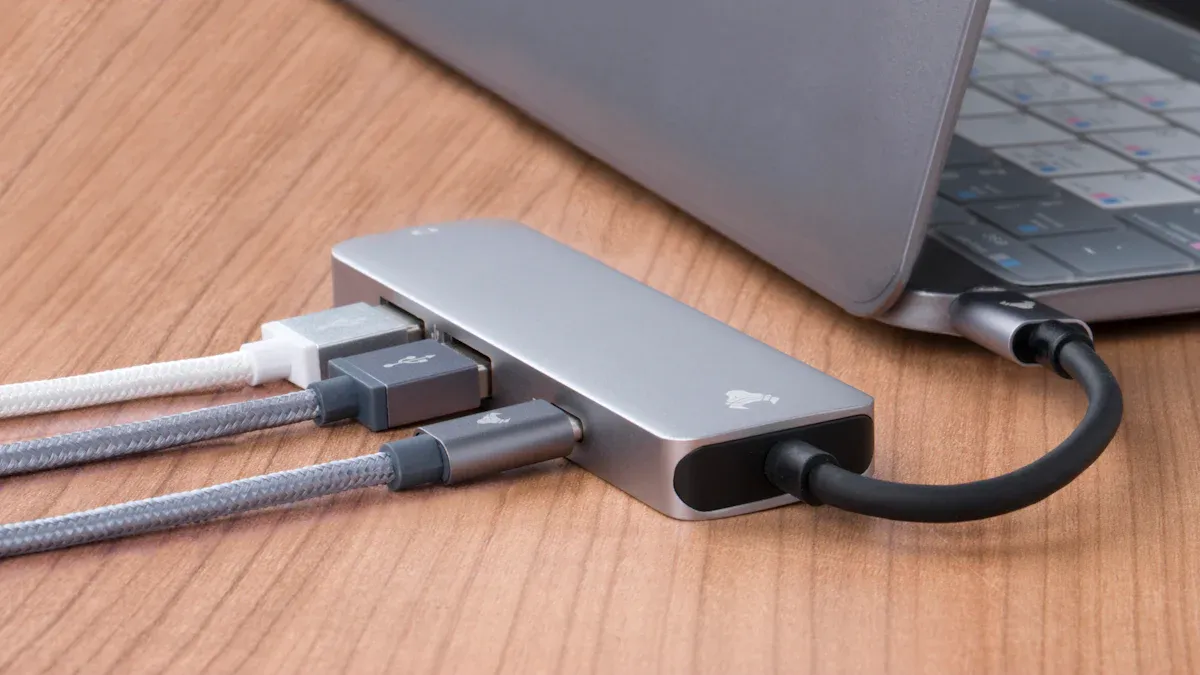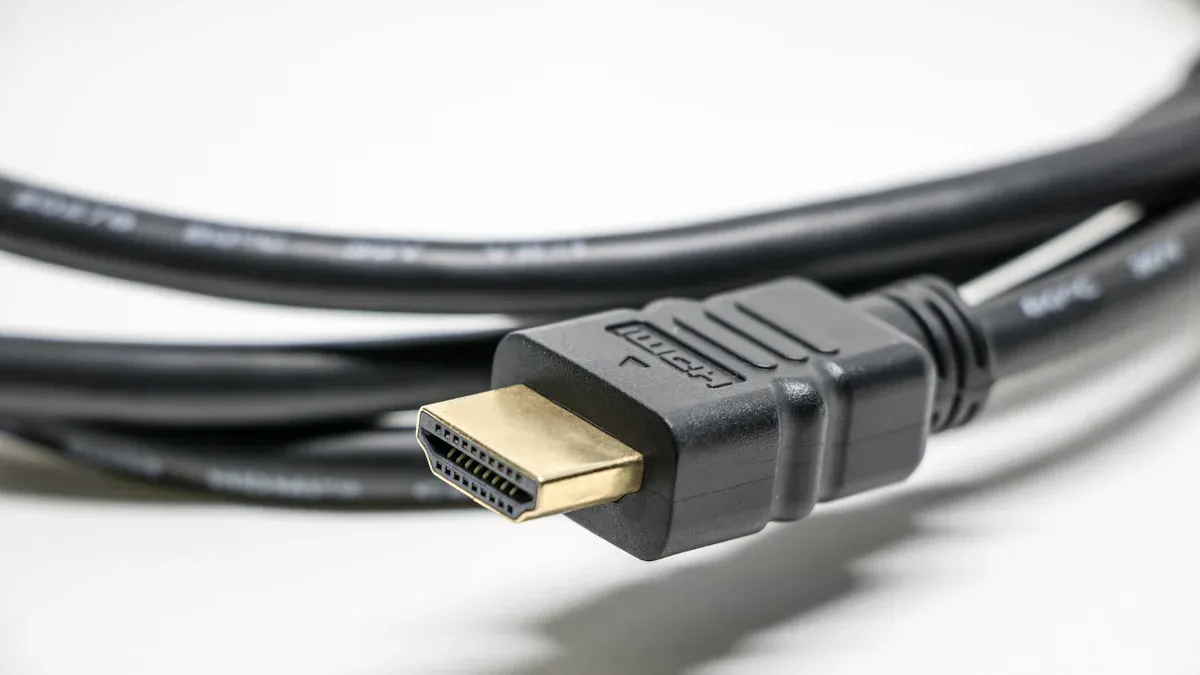Manufacturer Of High Quality Data Cable
Manufacturer Of High Quality Data Cable

You plug in your USB-C to HDMI adapter. Nothing happens. You feel upset, but you are not the only one. Most problems happen because of device compatibility, power supply issues, or overheating. Look at this quick table. It shows the main reasons adapters do not work:
Reason | What Happens |
|---|---|
Compatibility | Adapter does not work with your device |
Power Supply | Signal stops or flashes on and off |
Poor Quality | Video or sound looks or sounds bad |
Recognition | Device does not notice the adapter |
Overheating | Adapter gets hot and stops working |
Do not worry! You will find easy fixes and good tips here.
Make sure all cables are plugged in tight. If they are loose, your device may not find the adapter.
Take out the adapter and restart your device. This easy step can fix problems with detection.
Update your device's drivers and system often. New updates can solve many problems with working together.
Change your display settings to fit your monitor. This stops blurry pictures or wrong screen shapes.
If your adapter gets too hot, unplug it and let it cool. Good airflow helps stop damage and lost connections.

You plug in your USB-C to HDMI adapter, but your device acts like nothing is there. This problem can feel frustrating, but you can fix it with a few simple steps. Most electronics makers recommend the following:
Check all connections. Make sure the USB-C end is firmly in your device and the HDMI end is secure in your TV or monitor.
Restart your device. Unplug the adapter, turn your device off, then turn it back on. Plug the adapter back in after the restart.
Update your drivers and operating system. Sometimes, your device needs the latest software to recognize the adapter.
Try another device. Plug the USB-C to HDMI adapter into a different computer or phone. This helps you figure out if the problem is with the adapter or your device.
Look for damage. Check the cable and adapter for any cracks, bends, or broken parts.
Tip: Many people forget to update their drivers or firmware. This step often solves the problem when your adapter is not detected.
You connect everything, but your screen stays black. This issue happens a lot, but you can fix it by checking a few things:
Loose connections can cause the signal to drop. Double-check that every cable is plugged in tight.
Your display might not support the resolution your device is sending. Try lowering the resolution in your display settings.
Some adapters only work with certain devices. If your USB-C to HDMI adapter is not made for your laptop or phone, it might not work at all.
Note: If you see a black screen, try unplugging and plugging the adapter back in. Sometimes, a quick reset helps.
A flickering or unstable image can make watching videos or giving presentations impossible. Here are some things you can try:
Make sure your adapter is getting enough power. Some adapters need extra power to work right.
Check your HDMI cable for damage. Even a small bend or break can cause the picture to flicker.
Try a different HDMI port on your TV or monitor.
Update your device’s drivers. Outdated software can cause signal problems.
If you have another USB-C to HDMI adapter, test it. Some brands work better with certain devices.
Here’s a quick look at how different brands and models perform:
Brand/Model | Issues/Performance | Price Comparison |
|---|---|---|
Cable Matters USB-C to HDMI 2.1 | Trouble with signals above 60 Hz | N/A |
Nonda USB-C to HDMI Cable | Works well, but future support is uncertain | N/A |
Anker Nylon USB-C to HDMI 4K Cable | Works great, only comes in 6-foot length | N/A |
Anker PowerExpand+ USB-C to HDMI | Works well, but costs more with no extra benefits | More expensive |
Plugable USB-C to HDMI 2.0 Adapter | Not compatible with late 2016 MacBook Pro | N/A |
Kimwood USB C to HDMI Adapter | Performs well, cheaper but feels lower quality | Cheaper than our pick |
Amazon Basics USB-C to HDMI Adapter | Well made, plastic build | N/A |
Satechi Aluminum Type-C to HDMI | Flimsy, did not outperform our pick | Expensive |
Remember: Not all adapters work the same way. Some brands may not work with your device, even if they look similar.
If you follow these steps, you can solve most problems with your USB-C to HDMI adapter at home. Always double-check your connections and try simple fixes first. You might be surprised how often a quick reboot or a new cable solves the issue.

You connect your device, but the picture looks fuzzy or stretched. This problem happens a lot with adapters. Here are some reasons why you might see low resolution or the wrong aspect ratio:
Unsupported resolution or refresh rate can make your screen look bad. Your device and display need to match.
Low bandwidth or data transfer issues can lower video quality.
Many adapters say they support 4K, but your device may only send HD (1080p). For example, the S22 Ultra has a maximum resolution of 3088x1440, not true 4K.
Knowing your device’s real resolution helps you set the right display settings.
Tip: Always check your device’s specs before changing settings. This step saves time and avoids frustration.
To fix these problems, try these steps:
Check if your adapter works with your device and display.
Plug in the adapter’s power supply if it needs one.
Adjust your device’s display settings to match your monitor’s resolution and refresh rate.
Move other electronics away from your adapter to stop signal problems.
Make sure your USB-C port supports DP Alt Mode.
You see a picture, but there’s no sound. This issue can be confusing. Here’s a table with common reasons and what they mean:
Issue Type | Explanation |
|---|---|
Power Supply Issues | Some adapters need extra power for sound to work right. |
Bandwidth/Data Transfer | Low bandwidth can hurt audio quality. Good cables help. |
Hardware Compatibility | Some adapters just don’t work well with certain devices. |
Driver/Firmware Issues | Old drivers can stop sound from working. Updates fix this. |
To get your sound working, follow these steps:
Open System Preferences.
Select Sound.
Go to the Output tab.
Pick the HDMI output.
Quit and restart your app.
Note: Sometimes, just unplugging and plugging in your USB-C to HDMI adapter can fix sound issues.
Sometimes, your adapter gets very hot after some use. If it feels too warm or stops working, it might be overheating. This can make your connection drop or even hurt your device. Here are some reasons why this happens:
Bad design keeps heat trapped inside the adapter.
Using the wrong power supply can make it too hot.
Old firmware or drivers can make the adapter work harder.
Broken or wrong hardware can stop heat from leaving.
You can stop overheating by doing a few easy things:
Check if your adapter matches your device.
Keep your drivers and firmware updated.
Give your adapter the right power.
Take breaks and put the adapter where air can flow.
Tip: If your adapter is hot, unplug it and let it cool down. This helps stop damage.
Your screen might flicker or sound may stop sometimes. Signal interference could be the reason. Many things can mess up the signal between your device and display. Here is a table to show the most common causes:
Source of Interference | Description |
|---|---|
Loose Connections | Make sure both ends are tight so you do not lose signal. |
Incompatible Hardware | Some adapters just will not work with some devices. |
Power Issues | Some adapters need more power for a steady signal. |
Low Bandwidth | Cheap or old cables can make video and sound worse. |
Environmental Interference | Keep other electronics away to stop signal problems. |
If you see these problems, unplug and plug your cables back in. Move other electronics away from your adapter. Use good cables for better results.
Note: A tight connection and the right hardware can really help your viewing.
You can fix most display or sound problems by checking your cables. Restart your device and update your software too. Try each step and make sure every cable is tight. If you still have problems, you may need more help.
Contact the company or customer service for help.
Think about if your hardware works together.
Here are some support and warranty choices from top brands:
Manufacturer | Product Description | Warranty | Support |
|---|---|---|---|
StarTech | USB C to HDMI Adapter - 4K 30Hz | 2 years | Free lifetime technical support |
OWC | USB-C Quad HDMI 4K Adapter | 1 year | Limited warranty |
OWC | USB-C Dual HDMI Adapter | 1 year | Limited warranty |
You can fix most problems at home. Stay calm and try each idea. You can do it! 😊
Not all USB-C ports support video output. Some only charge or transfer data. Check your device’s specs. If your port supports “DisplayPort Alt Mode,” your adapter should work.
Most adapters support 60Hz at 1080p or 4K. For gaming, you need a high-quality adapter and cable. Check both for refresh rate support. Lower-quality adapters may lag or flicker.
A little warmth is normal. If it feels too hot to touch, unplug it and let it cool. Overheating can damage your adapter or device.
Tip: Place your adapter in a spot with good airflow.
You may need to select HDMI as your audio output. Go to your device’s sound settings and pick HDMI. Some adapters need extra power for sound.
Step | What to Do |
|---|---|
1 | Open sound settings |
2 | Select HDMI output |
3 | Restart your app |
Yes, for 4K video, use a “High-Speed HDMI” cable. Regular cables may not work well. Check the cable label or packaging for “4K” or “High-Speed.”